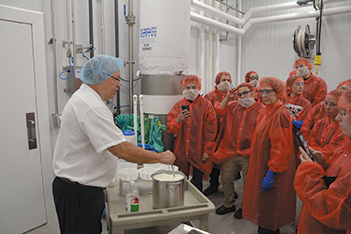 |
|||


|
 |


|
|

Innovation in U.S. dairy ingredients opens opportunity in global markets
Editor’s note: Welcome to Ingredient Innovation, CMN’s new segment exploring recent innovations and trends in the dairy ingredients sector. For this segment, we will profile a leader in the ingredients industry as well as share updates on mergers and acquisitions and new offerings for cheese and dairy in ingredients — where flavor begins.
|
Photo courtesy of Center for Dairy Research, University of Wisconsin-Madison |
| RESEARCH AND TRAINING — The Center for Dairy Research at the University of Wisconsin-Madison is one of six National Dairy Foods Research Centers supported by Dairy Management Inc. that helps to develop and improve dairy products for domestic and export markets. |
 |
| Photo courtesy of U.S. Dairy Export Council |
| TASTY TOPPING — The U.S. Dairy Export Council has helped to identify and develop ways to use U.S. dairy ingredients in regional-specific foods. For example, in Japan, dairy proteins have been incorporated into furikake, a popular topping for rice, in order to boost nutritional value. |
By Rena Archwamety
MADISON, Wis. — U.S. dairy ingredient exports have been growing at record levels, thanks in large part to coordinated, long-term product and market research efforts led by checkoff-funded organizations.
The United States exports approximately 18% of its total milk production, and in 2021, U.S. dairy export volume (on a milk solids basis) grew 10% over the previous year. Dairy ingredients make up the majority of these exports and have helped drive growth and demand for U.S. dairy.
“We’re seeing that growth across all parts of our ingredient portfolio for U.S. dairy,” says Vikki Nicholson-West, senior vice president of global ingredients for the U.S. Dairy Export Council (USDEC).
Nonfat dry milk (NDM), skim milk powder (SMP) and dry whey export volumes all were up 10% in 2021, while whey protein concentrate rose 11%, all setting new records, according to USDEC. And there remains plenty of room for more growth.
“We’re really feeling very positive about the outlook for dairy ingredients. They are a key part of exports and a key supporter to driving milk consumption,” Nicholson says.
• Dairy research centers
Dairy Management Inc. (DMI) manages farmer funds to promote dairy exports through USDEC as well as support six National Dairy Foods Research Centers across the United States (https://www.usdairy.com/getmedia/5494b677-5437-47a9-9fa1-2fae8bbddd26/research
centerbrochure.pdf.pdf). Much of the work at these research centers is focused on developing and improving ingredients specifically for targeted export markets.
The National Dairy Foods Research Centers often are the first point of contact for dairy companies when testing out a new ingredient or process, according to Hari Meletharayil, DMI vice president of dairy products research for cheese, beverage and commodity platforms.
“Some of the export market products need to be customized because the taste or functionality is different in that market,” Meletharayil says. “To understand what is needed, what process or modification needs to be done, the dairy center works with them so it performs well in export markets.”
For example, he notes a lot of work to help products meet the right sensory profiles for overseas markets is done at the Southeast Dairy Foods Research Center at North Carolina State University, while the Center for Dairy Research at University of Wisconsin-Madison has researchers who work to extend the shelf life of exported U.S. cheeses. Other centers that also provide resources for dairy ingredients or exports include the California Dairy Innovation Center, Western Dairy Center, Midwest Dairy Center and Northeast Dairy Foods Research Center.
“Exports are very important for growth as 96% of the population lives outside of the United States,” notes Rohit Kapoor, DMI vice president of dairy products research for powder ingredients, co-product and sidestream platforms. “We have leveraged our dairy center partnerships to help utilize resources at these dairy centers to address product and research needs.”
Some key initiatives for exported products, he notes, are improving shelf life and functionality, as well as researching the benefits of dairy proteins compared to other proteins.
One example of a highly successful, long-term collaboration between DMI, the National Dairy Foods Research Centers and USDEC is a milk powder enhancement program that began in 2011 and was a seven-year initiative. Kapoor explains U.S. processors make a lot of high-quality milk powders like NDM and SMP, but back then the market was focused on local applications such as bakery, ice cream and processed cheese.
When the initiative started to export those products, one of the key applications in markets such as Southeast Asia and China was to reconstitute these ingredients for shelf-stable UHT milk. One key requirement for this application would be for the milk powders to have much lower spore counts to meet stringent specifications for these products.
“We did 33 different projects addressing how to mitigate and reduce spores across the value chain, from the farm to when the powder was in the bag,” Kapoor says. “It spanned across 10 universities and many of the dairy center exports. USDEC and DMI were able to co-create resources for many processors — bringing the research findings to “Spore Seminars” — where we could disseminate what we learned and the tools we were able to develop. Some of the largest dairy companies and cooperatives would come to those, and many have incorporated various tools and techniques we developed in that process.”
This collaboration led to a major increase in both the quality of U.S. milk powders and the volume that now is exported to overseas markets. According to USDEC data, NDM/SMP exports to Southeast Asia nearly doubled from 178,343 metric tons in 2011 to 320,193 metric tons in 2021, and these exports to China nearly quadrupled from 14,973 metric tons in 2011 to 53,241 metric tons in 2021.
“A few years ago, we benchmarked U.S. powders across multiple criteria and found it was meeting — if not exceeding — product from other competitors,” says Nicholson-West. “We have a great product, and we’re working diligently to make sure customers know how great a product we have to export.”
• Custom applications
In 2020, USDEC established its first U.S. Center for Dairy Excellence in Singapore. This was a first-of-its-kind ideation hub and collaboration space designed to spark innovative applications and share the story of U.S. dairy products and sustainable production with culinary professionals, opinion leaders and other partners in the region. More detailed insights on this new center, as well as opportunities for dairy ingredient exports in Southeast Asia, will be presented by USDEC at the upcoming Dairy Products, Processing and Packaging Innovation Conference in California Oct. 11-13 (https://dairy.calpoly.edu/short-course-symposia).
“We focus on that region because we consider it a gateway,” Nicholson-West says. “We also have partnerships in markets such as Vietnam, Japan and Korea, to find applications and spur ideas for end users to use dairy ingredients in unique and local-friendly ways, more tailored to their needs.”
One example of tailoring U.S. dairy products to specific local uses is in Japan for use in rice toppings.
“There is a topping normally put over rice or vegetable called furikake, and we’ve incorporated dairy proteins in that,” Nicholson-West says. “It’s a very carb-laden topping, and now there is a way to add protein, especially for those who may be flexitarians and not consume traditional animal meat proteins.”
Dairy proteins also have been incorporated into porridges or puddings with popular local flavors like mango, ideal for seniors looking for easy, nutritious and palatable dishes or treats. Other applications for ingredients like dairy proteins and permeate include local-style desserts, bakery applications, sports nutrition and sodium reduction.
“Here we’re familiar with sports bars, but there it might be bites, rounds or mini balls,” Nicholson-West says. “In seasonings, dairy permeate offers the benefit of adding flavor and reducing sodium. For dishes like Ramen noodles that typically are high in sodium, this is an opportunity to reduce the sodium content.”
Meletharayil notes that one of DMI’s big areas of focus for research is health and wellness, and there are some current projects with university research partners to help increase the ways in which dairy ingredients can be used in this category.
“These (applications) ultimately can be used not only in the U.S., but they are gaining a lot of traction across the globe. Some of these projects will help position the U.S. as a global leader in the health and wellness sector,” he says.
Nicholson-West adds that dairy proteins are very well-positioned to meet demand for more nutritious foods, especially as the recent pandemic has brought health and wellness to the forefront in areas around the world.
“Whey protein concentrate and milk protein concentrate are in a great position to meet those consumer food needs,” she says. “We feel dairy ingredient processors are in a great position to meet those consumer needs and trends. They tick all the boxes — sustainable, nutritious, superior application and quality. We’re really excited about growth opportunities in that realm.”
CMN
| CMN article search |
|
|
© 2025 Cheese Market News • Quarne Publishing, LLC • Legal Information • Online Privacy Policy • Terms and Conditions
Cheese Market News • Business/Advertising Office: P.O. Box 628254 • Middleton, WI 53562 • 608/831-6002
Cheese Market News • Editorial Office: 5315 Wall Street, Suite 100 • Madison, WI 53718 • 608/288-9090
